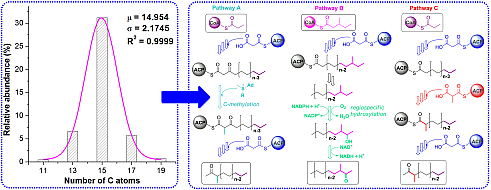
A NOTE ON THE BIOSYNTHESIS OF LONG-CHAIN 3-METHYL-2-ALKANONES FROM THE ROOT ESSENTIAL OIL OF INULA HELENIUM L. (ASTERACEAE)
Abstract
A predominantly odd-numbered, Gaussian-like distribution of the relative amounts of 3-methyl-2-alkanones, from I. helenium root essential oil, was observed. This distribution pattern indicates that their biosynthesis is related to that of fatty acids and related compounds. Simple (non-branched) 2-alkanones also show an odd carbon number prevalence in plants and other organisms, and it was shown that their biosynthesis indeed proceeds via the acetate pathway. In this paper, we propose three possible biosynthetic pathways by which 3-methyl-2-alkanones could be formed in the plant tissues. The essential distinction between them lies in the way the branching methyl group is introduced. The Gaussian parameter σ for the observed distribution of these ketones could be interpreted as the error introduced by the first elongase enzyme system involved in the biosynthesis of fatty acid-derived compounds.
BIOSINTEZA 3-METIL-2-ALKANONA DUGOG UGLJOVODONIČNOG LANCA IZ ETARSKOG ULJA KORENA BILJNE VRSTE INULA HELENIUM L. (ASTERACEAE)
3-Metil-2-alkanoni dugog ugljovodoničnog lanca su nađeni u etarskom ulju korena biljne vrste I. helenium L. Uočena je Gausova raspodela njihovih relativnih količina, pri čemu su homolozi sa neparnim brojem C-atoma bili zastupljeniji. Ovakva raspodela ukazuje na to da njihova biosinteza protiče veoma slično kao i biosinteza masnih kiselina i srodnih jedinjenja. 2-Alkanoni sa neparnim brojem C-atoma su, takođe, zastupljeniji kod biljaka i ostalih organizama, a za njih je dokazano da zaista nastaju po gore pomenutom acetatnom biosintetskom putu. Imajući sve ovo u vidu, predložili smo tri moguća biosintetska puta kojim bi 3-metil-2-alkanoni mogli nastati u biljnim tkivima. Osnovna razlika između predloženih puteva je u načinu na koji se uvodi metil račva. Gausov parametar σ uočenih raspodela količina alkana bi se mogao posmatrati kao greška prvog enzimskog sistema elongaze koji učestvuje u biosintezi masnih kiselina i jedinjenja koja se iz njih izvode.
HIGHLIGHTS
- Homologous 3-methyl-2-alkanones (C11–C19) detected in Inula helenium root essential oil had a predominantly odd-numbered Gaussian-like distribution.
- This specific distribution pattern indicates that their biosynthesis most likely proceeds via the acetate pathway.
- There are three possible biosynthetic pathways, with a different mode of introducing the methyl branch, by which 3-methyl-2-alkanones could be produced.
- The observed Gaussian parameter σ could be interpreted as the error of the first elongase enzyme system involved in the biosynthesis of fatty acid-derived compounds.
Full Text:
PDFRefbacks
- There are currently no refbacks.
ISSN 0354-4656 (print)
ISSN 2406-0879 (online)